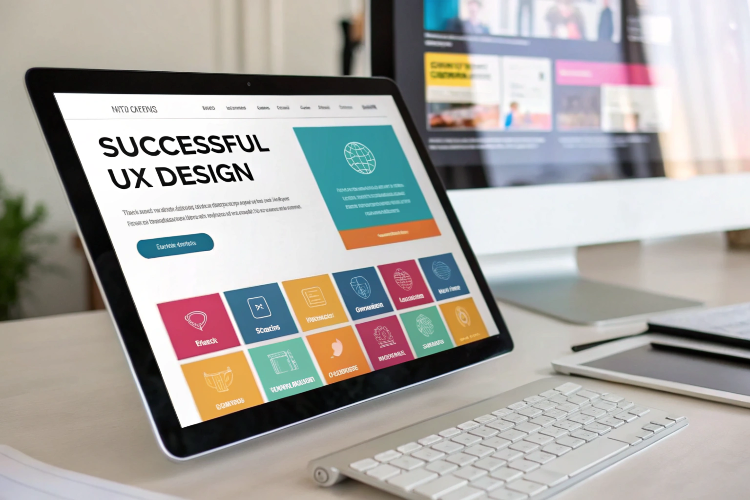The Role of UX/UI Design in Website Success .

In today’s digital world, having a website is not enough; it must be visually appealing, user-friendly, and highly functional. This is where UX (User Experience) and UI (User Interface) design play a critical role in determining a website's success. A well-designed UX/UI ensures that visitors enjoy seamless navigation, find relevant information quickly, and engage with the website effectively, ultimately leading to higher conversions and business growth.
This blog explores the significance of UX/UI design, best practices for an optimized website, and how investing in design can impact your online success.
What is UX/UI Design?
User Experience (UX) Design
UX design focuses on the overall feel of the website and how users interact with it. It involves research, usability testing, and strategy to enhance user satisfaction by improving accessibility, efficiency, and overall experience.
User Interface (UI) Design
UI design refers to the aesthetic and interactive elements of a website, including color schemes, typography, buttons, icons, and layout. A well-designed UI ensures that the website is visually appealing and easy to navigate.
Why UX/UI Design Matters for Website Success
1. Enhances User Engagement
A website that is intuitive and visually appealing keeps users engaged. If users struggle with navigation or encounter a poor layout, they are likely to leave, increasing the bounce rate.
2. Improves SEO Rankings
Search engines like Google consider user experience when ranking websites. Websites with optimized UX/UI tend to have lower bounce rates, longer session durations, and higher engagement—factors that positively impact SEO.
3. Boosts Conversion Rates
A well-structured UI with clear CTAs (Call-to-Actions) guides users toward desired actions such as signing up, purchasing, or contacting the business. Improved usability leads to increased conversion rates and revenue.
4. Reduces Bounce Rate
If users find a website confusing or slow, they leave immediately. Optimized UX/UI ensures smooth navigation, making users stay longer and explore more content.
5. Enhances Brand Credibility
A professional, well-designed website builds trust and credibility. A cluttered or outdated design can harm a brand’s image and deter potential customers.
Best Practices for UX/UI Design
1. Mobile-First Design
With mobile traffic surpassing desktop usage, ensuring a mobile-responsive design is crucial. Key considerations:
-
Use a responsive design that adapts to various screen sizes.
-
Optimize images and content for mobile viewing.
-
Ensure touch-friendly navigation elements.
2. Fast Loading Speed
Website speed significantly impacts user experience. Ways to enhance speed include:
-
Compressing images and optimizing media files.
-
Minimizing HTTP requests and enabling caching.
-
Using a fast and reliable hosting service.
3. Intuitive Navigation
Users should easily find what they’re looking for. Key navigation elements:
-
Clear and well-structured menus.
-
A search bar for easy access to content.
-
Logical page hierarchy with breadcrumbs.
4. Clear and Consistent Branding
Consistency in design elements strengthens brand identity. Ensure:
-
A unified color scheme and typography.
-
High-quality images and graphics.
-
A memorable and recognizable logo placement.
5. Accessibility for All Users
An inclusive design benefits all users, including those with disabilities. Key aspects:
-
Use readable fonts and appropriate contrast.
-
Implement keyboard navigation and screen reader compatibility.
-
Add alternative text (alt text) for images.
6. Engaging Call-to-Actions (CTAs)
CTAs should be visible, compelling, and strategically placed. Best practices:
-
Use action-oriented language (e.g., “Get Started,” “Sign Up Now”).
-
Ensure CTAs stand out with contrasting colors.
-
Place CTAs at logical points throughout the site.
7. User Testing and Feedback
Regular testing ensures that the design remains user-friendly. Methods include:
-
A/B testing to compare different design versions.
-
Heatmaps to analyze user interactions.
-
Collecting user feedback for continuous improvements.
The Impact of UX/UI on Business Success
1. Increased Customer Retention
A smooth and engaging user experience encourages repeat visits and customer loyalty.
2. Competitive Advantage
Companies that invest in UX/UI design gain a competitive edge, as a superior design can differentiate a brand from competitors.
3. Higher Revenue Generation
An optimized UX/UI design leads to improved engagement, increased conversions, and higher revenue.